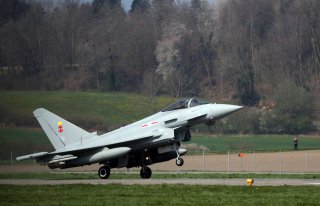Could Europe's Typhoon Tangle With Russia's Su-35 Fighter And Live?
The Typhoon has some advantages.
Here's What You Need To Remember: There is no question that Russian jets have come a long way technologically since the end of the Cold War. The Su-30 and especially the Su-35 are excellent fighters—and they’ll be a handful for any Western fourth-generation fighter in the event of a war. But at the end of the day, the Russian machines still lag behind on in terms of sensors and pilot vehicle interfaces.
With heightened tensions in Europe over Russia’s actions Ukraine, NATO countries have stepped up their air patrols over the Baltic states of Estonia, Latvia and Lithuania. While the U.S. Air Force often deploys aircraft to help police the air space over those former Soviet republics, often the task falls to European air arms to keep Moscow in check.
For many of those European forces, including Great Britain, Germany, Italy and Spain, their aircraft of choice is the Eurofighter Typhoon. Developed originally as a purebred air superiority fighter, the Typhoon excels in the air-to-air arena. In the unlikely event of a conflict, the Eurofighter is likely able to more than hold its own against late generation Flanker variants like the Sukhoi Su-35S. While the Russian and European machines each have their advantages, the jets are very comparable overall.
Indeed, Royal Air Force (RAF) Typhoons recently trained with their Indian Air Force (IAF) Su-30MKI Flanker-H counterparts and found that to be true. “First impressions of the Flanker are very positive,” Wing Commander Chris Moon, commander of 3(F) Squadron said in a statement. “It is a superb aeroplane and it’s a privilege to operate our Typhoon alongside it.”
The Indians were also fairly impressed with the Typhoon—noting that the two machines are more or less evenly matched. “Both are fourth generation aircraft and so are matched evenly, so the learning value comes from the person to person contact,” said IAF Squadron Leader Avi Arya in a statement to the RAF. “It’s the man behind the machine which matters.”
As Arya noted, most fourth-generation fighters like the Su-35 or Typhoon offer comparable performance. Pilots of each type of aircraft have to learn how to operate their aircraft to the limits of their capabilities. That means exploiting the strengths of your aircraft and avoiding its weaknesses.
In the case of the Flanker, that means using its excellent low speed handling—thanks to its thrust vectoring capability—to offset the Typhoon’s very, very high turn rate and excellent energy addition while exploiting its poor high angle of attack capability. That’s similar to how U.S. Navy and U.S. Air Force pilots flying the F/A-18 Hornet and the F-15 Eagle fight the Typhoon in a visual range engagement. It pretty much comes down to the individual—and luck.
Beyond visual range, technology plays a greater role, but tactics, training and procedures are key. Groups of fighters have to coordinate with each other and their AWACS or ground controllers. As an example, one senior U.S. Air Force instructor pilot explained that if there were a four-ship of F-15s versus another four-ship of F-15s using standard “blue” tactics—unless someone makes a mistake—the each engagement would end in a draw. Moreover, those tactics are generally held close to the vest. For example, U.S. Air Force units don’t generally employ their cutting edge tactics during international exercises since that might compromise those techniques.
Technology-wise, neither the Su-35 Flanker nor the Typhoon is currently equipped with an active electronically scanned array radar, but both have good beyond visual range capability. Both jets are designed for high speed, high altitude beyond visual range engagements, and as such, can impart an enormous amount of launch energy to their beyond visual range weapons. But it is not known how effective Russian combat identification systems are—you have to know what you’re shooting at. Further, the Typhoon’s cockpit and pilot vehicle interface are excellent—much better than anything found on the current Flanker variants.
The Typhoon also has one other advantage. In the coming years, the RAF will start to deploy the MBDA Meteor missile. The Meteor, which is a long-range ramjet powered weapon, is quite possibly the best beyond visual air-to-air missile developed to date. It has excellent end-game performance and could be the Typhoon pilots’ trump card—at least until the Russians develop an equivalent.
There is no question that Russian jets have come a long way technologically since the end of the Cold War. The Su-30 and especially the Su-35 are excellent fighters—and they’ll be a handful for any Western fourth-generation fighter in the event of a war. But at the end of the day, the Russian machines still lag behind on in terms of sensors and pilot vehicle interfaces. As such, the smart money is on the Typhoon.
(This first appeared back in 2015.)
Image: Reuters.

